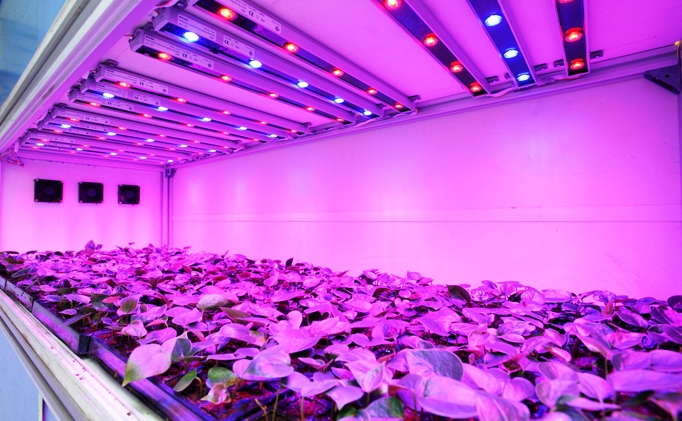LED Grow Lights – Weeding Out The Myths
Posted by Amit Soni on 7th Jun 2012

More and more people are beginning to realise that energy-efficient LED lights are the most cost-effective form of illumination for their homes and businesses, but did you know that they have a great deal to offer as far as the agricultural industry is concerned as well?
It’s a good job that they do, because scientists have estimated that in as little as 50 years, as a consequence of out of control population growth, demand for food will make the adoption of more advanced farming methods a necessity.
By replacing traditional grow light technologies with LEDs, farmers will be able to produce food in greater quantities while simultaneously consuming fewer resources.
As with any relatively new and innovative form of technology, however, LED has been viewed with suspicion in certain quarters and, as a result, myths have sprouted and taken root; myths that require weeding out!
Myth One: Led Grow Light Technology Isn’t Advanced Enough Yet
This is quite possibly the most perplexing of all the current myths, considering the fact that LED bulbs are known for their advanced engineering and technological complexity, and the LED lights used in plant propagation definitely live up to this reputation.
Modern LED grow lights are precision-made to accommodate the specific needs of plants, thereby providing the optimum stimulus for growth and development.
For instance, unlike conventional fluorescent and halogen/incandescent bulbs, LEDs are engineered to produce primarily blue and red wavelengths of light. These wavelengths consist of a spectral range known as PAR (Photo-synthetically Active Radiation). This is the amount of light available for photosynthesis, and is in the 400 to 700 nanometre wavelength range. PAR changes according to the season and varies depending on the time of day and the latitude at which the plants are grown. Readily absorbed by the chlorophyll in plants, PAR wavelengths have by far the greatest impact on photosynthesis, leaf development, and flowering.
Traditionally-used light sources generating additional wavelengths are simply wasting their energy, as the other colours are of very little use to plants. This is the reason why plants have green leaves. Unused by plants, light in the green part of the spectrum is reflected not absorbed. Thus, the reflected, unabsorbed light makes leaves appear to be green.
Hi-tech, modern LED grow lights also contribute significantly to plant protection. Engineered into every LED bulb is a highly efficient heat sink, which restricts heat loss. Not only does the minimized heat loss save energy, it saves plants from damaging overexposure to high temperatures. The heat sink is also responsible for LED grow lights’ incredible longevity, as it effectively dissipates any potentially bulb- damaging, light-degrading heat.
Myth 2 – The Savings Aren’t Worth the Risk
Certainly, there cannot be any serious kind of risk as far as increased levels of yield are concerned, because LED grow lights’ superior productive capacity is already widely recognised.
Thanks to their fully-integrated heat sinks and PAR-focused light emission, modern LED grow lights offer gardeners and crop-growers substantial energy efficiency and consequent financial savings. The savings are furthered by the aforementioned longevity of LEDs, which have an average life-expectancy that’s well in excess of 50,000 hours. This means you’ll be able to use them for around 17 years before they need to be replaced. This is one of the reasons why the particular myth about LED grow lights’ long-term viability is so baffling.
This can be demonstrated when the statistics pertaining to LED grow lights are scored against those of their immediate competitors, the HPS (High-Pressure Sodium) bulbs. These would be the scores:
- HPS Bulbs have a yield of 0.5 grams per watt.
- LED Bulbs have a yield 1gram to 1.5 grams per watt, or up to three times the yield power of HPS.
In already established industries such as this, there will always be the fear of trying something new and finding a quality product that won’t damage produce. Admittedly, LED technology warranted some careful research in the beginning, but now its track-record has been proven and LEDs are sweeping the market. It’s interesting to note that, just over a century ago, people like Thomas Edison were experiencing the same level of scepticism when he introduced his incandescent light bulb.
Myth 3 – Old-School Growers Are Mired In The Past
This couldn’t be more wrong. In fact, encouraged by the clear-cut advantages of modern LED grow lights, an increasing number of growers are switching to LED lighting, and the migration isn’t simply limited to domestic gardeners; the whole world, it seems, is replacing its outmoded traditional light sources with energy-saving LEDs.
According to a recent market research report, the global LED grow light market is expected to rise to more than $1.9 Billion, which represents an exponential growth rate of 26.93% by the year 2020. The report points out that the increasing usage of LEDs is expected across all aspects of the agriculture industry covering applications as diverse as indoor and vertical farming, as well as in commercial greenhouses.
Now the facts have been brought to light and some of the myths debunked, it becomes easier to distinguish between the two. So, if you’re a plant grower or even just someone that likes to get the best possible value-for-money, LED lighting is definitely the way to go.
The one question is, can you dig it?





